#garangolm
Explore tagged Tumblr posts
Text

Tranquil 🌱
#garangolm#bishaten#rajang#monster hunter#monhun#monster hunter rise#モンハン#monster hunter fanart#my art
80 notes
·
View notes
Text

Oh I forgot to post this. Garangolm lass with a big hammer :)
#illustration#digital art#comics#illustrator#drawing#sketchbook#art#makecomics#artist#makingcomics#monster hunter#garangolm#hammer#mhworld
271 notes
·
View notes
Text


Official Monster Hunter Rise: Sunbreak concept art: Garangolm armor design
#Monster Hunter#garangolm#monsterhunterofficial#monster hunter#monhun#monsterhunter#mh#モンスターハンター#モンハン
98 notes
·
View notes
Text
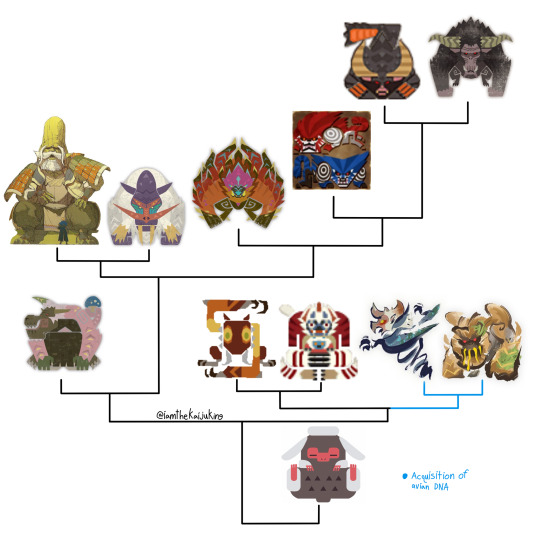
My phylogeny of the cursorial monkeys as of the release of Wilds
Gold & Pearlspring Macaque: Two species of monkey native to the hoarfrost reach.
Both species are small primates that usually take shelter in the underbrush and in caves scrounging around for small animals, and have thick fur to combat the cold. But sometimes this isn’t enough so they risk basking in hot springs to stay warm. The Pearlspring species is numerous and social, forming large family troops. The golden species is much rarer but seems to be welcomed as the Pearlspring make no efforts to drive them off.
Both species have long feet and when resting have a plantigrade leg position, but when moving they switch to digitigrade, which is a hallmark of this entire family.
Despite their appearance resembling lemurs or loris, they and by extension all members of this group are old world monkeys with close relation to the tribe Papionini (mandrills, macaques, baboons, geladas, etc). But the group itself is likely older than them.
True cursorial monkeys
Congalala: An infamously stinky species with vibrant fur.
These monkeys are somewhat social and forage together, but don’t form especially strong bonds with each other. Congas are primarily fungivores that also eat plant matter but especially fruits. They spend a lot of time digesting their hardy meals with their large and extensive digestive system which is capable of slight hind gut fermentation. Their tails are prehensile and have a padded tip for picking up food. Their mouths are especially gummy, and in fact all but the canines and incisors on their mandibles are blocked from view by their extensive gums. This gives them a slight hippo look.
For self defense Congas have large claws derived from grooming claws that can give a nasty slash and their faces and rear can flush red with blood as a warning when angry, but this pales in comparison to their other defense. The colon of the Conga is formally referred to as the Fart Chamber, and is rather large and capable of retaining waste and gas. In self defense a Conga will release the contents of its fart chamber and the foul smell and fecal matter is enough to drive away almost any attacker. There is traces of sulfur that give it a particularly strong smell and make it hard to wash out.
The iconic pink fur of Congas seems a bit odd, but is actually a vital method of anti parasitic defense. Many tropical species such as birds use bright colors in their integument as a deterrent against external parasites.
The males known as Congalala are much larger than the females and more solitary, but a Congalala usually isn’t far from a troop of Congas he’s claimed as a harem. Males have long fur on their heads that they gel into a long curved cone using the juices from the fruit they eat. This is something done to show fitness to other females, and males with bigger and more impressive cone heads are considered more attractive.
As a consequence of their more solitary lifestyle, Congalalas step up their chemical defenses. Aside from their fart chamber, they also have a small pocket in their esophagus next to the entrance of their stomach called the Burp Chamber. When eating various toxic fungi they can actually store some of the debilitating chemicals along with gas within the burp chamber to then be regurgitated at attackers.
Some particularly experienced Congalala have found ways to dye their hair as well as gel it, and these individuals have died their entire bodies a number of different colors in order to further impress females. Green is the most common but some orange individuals have been spotted.
Blangonga: An arctic species of monkey with a much more carnivorous diet.
Blango are well adapted to their environment with thick white coats that cover their bodies, except for their extremities and bald heads. They form troops to hunt as a pack to capture prey which they dispatch via their massive canines. Much like Mandrills they have distinct blue faces with snout ridges. In defense they can spew water which freezes in their cold habitats.
While most of their caloric intake is meat, Blango must occasionally consume plant matter. As monkeys they are incapable of producing vitamin C, and must gain it through food. Vitamin C is common in fruits and vegetables, but these are not common where they live, so any plants they see they will eat without hesitation to avoid scurvy. Troops may seasonally migrate during warmer periods to gorge on fruits.
Males are referred to as Blangonga and aside from size they have noticeable cranial differences from females. Their upper canines form incredibly long sabers, and they have two long bone spikes on their skulls above the canines as well as a distinct mustache growing from the cheeks. Just behind their head is also a lump of fat. These tusks, mustaches, and head boobs make them very desirable to females, and a single Male may command an entire troop of Blango. This does not mean that Blango are loyal though, as they will abandon a Blangonga that receives facial wounds that cut their mustache and breaks their tusks. These abandoned Blangonga do not survive long.
A desert subspecies exists called Copper Blangonga, which has a brown and tan coloration. They do not regurgitate water in defense as it does not freeze in their hot habitat. They’re also solitary and possibly do not possess sexual dimorphism. It’s possible that after the end of the last ice age a population of Blango became stranded in the old desert.
The dental formula of Blangonga perfectly matches with old world monkeys, with the only weird thing being that the first premolars are sharp like sideways triangular incisors. Likely an adaptation for their higher intake of meat.
Wyverians: A sapient species with long lifespans that closely resemble Homo sapiens.
It may be controversial to place them here as Wyverians hold a firm belief that they are descended from wyverns (although what kind is never specified), but a number of anatomical features say otherwise. A belly button and breasts present in many individuals firmly places them as placental mammals, and their anatomy is firmly simian. They nearly perfectly resemble humans except for their four fingered hands and feet, and the fact that they can have digitigrade legs and grow bigger than humans.
It’s these limbs that are the biggest tell as they match perfectly with the cursorial monkeys. But why lose their tails and evolve to be upright? Perhaps it could be to better free up their arms for tool use, and as they oriented their bodies vertically the tail offset their balance and was lost. Much like humans, this upright posture meant the head was held up by simply sitting on the neck vertebrae and not be held up by neck muscles that attached to the cranium. Thus allowing their brains to expand.
Many individuals can grow to astonishing size and males can become especially enormous and grow a distinctive domed head possibly composed of firm fat. The biggest known Wyverian is His Immenseness, who perfectly exemplifies these traits. These traits could perhaps be an evolutionary holdover from their sexually dimorphic ancestors who had keystone individuals in their troops.
Wyverians also live unnaturally long lifespans, rivaled only by the Actinistian elder dragons. It’s unknown why they possess such ludicrously long lives, or why it would even be necessary evolutionarily. But allow me to present a theory.
We know that many ancient civilizations have fallen in the world of monster hunter, and some especially advanced ones had access to genetic engineering. Wyverians typically inhabit the upper echelons of society or more academic spaces, with exceptions such as blacksmiths. It’s rather likely that this is a holdover from the ages long lost, and it’s not impossible that Wyverians may have gifted themselves long lives as members of the ruling class. Food for thought.
Ajarakan: A volcanic species that decorate themselves in ore that they heat up.
Ajarakan, Rajang, and their closest relatives form a family of long snouted cursorial monkeys that ancestrally dwelled in volcanic environments. This ancestor had a very high heat tolerance and consumed minerals to enable its higher degree of biomineralization than what’s standard for monsters.
Ajarakan itself deposits most of its ingested ore on its dorsal side, which form large flame-like structures. In defense they use friction via beating their tails against their backs and rubbing themselves against the ground to heat up their ore to the point of glowing with heat. They can get so hot that they melt some rocks on contact.
Ajarakan are noticeably more arboreal than their relatives, and have no trouble navigating their environment vertically. To aid this they have very specialized hair on their hands. Their palms and fingers are like those of geckos and work the same way, being covered in thousands of hairs arranged in lamellae. This structure takes advantage of Van Der Waals forces much like the feet of spiders and gives them unparalleled grip.
Ajarakan have minimal sexual dimorphism and are largely asocial, but the population native to the oilwell basin form coalitions during the firespring to look out for Nu Udra. The house sized octopodes have a particular distaste for the monkeys as they are the only native species capable of reaching and eating their eggs.
Ajarakan’s dentition on their top jaw has the same amount of teeth as old world monkeys, with 16 teeth. Standard fare, 4 incisors, 2 canines, and presumably 4 premolars and 6 molars. So a dental formula of 2.1.2.3.
The bottom jaw is a little more unusual with 4 incisors, 2 small canines grouped with the incisors, 2 premolars that have taken the role of canines, and presumably 4 more premolars and 6 molars or 2 more premolars and 8 molars. So the dental formula for the lower jaw would be 2.1.3.3. or 2.1.2.4. The grouped together incisors and canines are similar to the condition on Rajang’s upper jaw, which might indicate that the ancestors of this group had tooth combs on their top and bottom jaws, and the first premolars took over the duty of canines.
Gougarf: A magnetic species with two distinct phenotypes.
Gougarfs are monkeys that ingest ferromagnetic metals and incorporate them into their tissues and give themselves a magnetic charge.
While the species itself lacks sexual dimorphism, there are two phenotypes. The blue Rey Gougarf known for their more wolf-like face and sharp V-shaped arch of fur on their backs. And the pinkish red Lolo Gougarf which has a pushed in bulldog face and rounded mane. These two different types have opposite magnetic charges and will work together to exploit this.
The species is very poorly understood due to the fact that Mezeporta hunters don’t like hunting them.
Voljang: A sister species to Rajang with ore infused armor that resides in volcanos.
Voljang are very rare but seem to have similar abilities to Ajarakan, even using friction to heat up their bodies. They lack the electrical abilities of Rajang.
Not much else is known.
Rajang: The most infamous species on this list, many hunters have been mangled in their attempts to take down this raging monkey.
Rajang are rare and usually found in habitats with extreme temperatures. Their diet primarily consists of meat. The species is violently asocial and doesn’t have sexual dimorphism. The large horns of Rajang sit on the rear of the skull roughly where a good chunk of the temporalis muscles would normally attach, so it is likely that Rajang (and by extension Voljang) have sacrificed surface area for jaw muscle attachments for these massive horns. The horns themselves are primarily defensive with slight display purposes. The bigger the horns on a Rajang, the less other Rajang will want to mess with it.
The most famous feature of the species is their brutal strength and electricity. Rajang ingest conductive ores. Usually this is copper, but if available they prefer gold. These metals both transfer the immense electrical energy they produce to different parts of their bodies, but also store some of it as well. When excited their fur glows a bright golden thanks to symbiotic microbes. Ordinarily these bacteria are hitchhikers only found in Rajang fur, but when the monkeys must defend themselves they are capable of electrogenesis and adding to the monkey’s power as a way of earning their keep. This immense electrical energy is regulated thanks to a ganglion present in the tip of the tail. If this ganglion is damaged or severed then a Rajang loses its ability to regulate its powers and its electrogenesis becomes self destructive. These individuals are known as Furious Rajang.
The disproportionate strength of the species may be possible due to their electricity. The way this electricity interacts with their muscles may grant them conscious access to hysterical strength.
Rajang have a distinct taste for the rhino Kirin, or rather their horns. The minerals and compounds present in the alicorn is vital for the monkeys to gain full access to their abilities. What precisely it is within the alicorn they need isn’t known though.
As is common among their relatives, Rajang tissues can withstand high temperatures, and when enraged a Rajang can become so hot that steam rises from it. Rajang can also flip up their upper lip like a gelada.
The dental formula of Rajang’s upper jaw is 2.1.2.3. Four incisors, two small canines grouped with the incisors (likely a remnant of a tooth comb), four canine-like premolars, and six molars with the first two being canine-like. The formula for the lower jaw is 2.1.1.3. Four incisors, two massive canine tusks, two sharp premolars similar to Blangonga’s and two missing, and six molars.
Gliding monkeys
Kecha-Wacha: A very strange and arboreal species that is a member of the other branch of the cursorial monkey family that still retain more of their arboreal origins, the gliding monkeys.
Kecha have a suite of bizarre physical features. Their large ears are very sensitive, especially to wood boring insects which they dig out with their claws. They can move their ears to cover their face, and these ears have eyespots that make them look bigger than they are to predators. These eyespots can also impress mates (although outside of mating, the species is solitary). Their eyes are huge and perfect for night vision. And their snouts form a trunk that can be aimed to shoot sticky snot at flying insects it intends to eat too.
The dentition of Kechas are just as unusual, with the dental formula being 2.1.2.2. on both jaws. Aside from having lost four molars, all of their teeth except for their canines are incisor-like. This is presumably for cracking open arthropod exoskeletons easier. Their lips are also slightly more reptilian to give themselves a bigger bite.
Their claws, aside from being useful for digging into trees, are also hooked at the tip like a sloth. This makes them excellent at clinging to and brachiating from branches without having to spend energy gripping them. Their tail hook is probably useful for the same reasons.
Kecha also have a large patagium. This is used for general fall speed deceleration and energy efficiency when leaping from tree to tree, but also has use in long distance travel. Sometimes Kecha climb to the highest point in their environment to leap off and catch wind currents to extend their glide. This is much more efficient than simply walking towards a new location.
A subspecies called Ash Kecha-Wacha exists that spends more time on the ground digging for insects in the dirt. Due to their lesser reliance on trees for protection, they’re capable of spewing fire at potential predators.
Gogomoa: A sloth-like relative to Kecha with silk abilities.
Gogomoa are perhaps the most arboreal of the cursorial monkeys as they are incredibly awkward on the ground. Their hands have lost a lot of their dexterity to converge strongly on that of a sloth and they spend most of their time upside down in the trees. Gogomoa have a highly reduced but noticeable patagium that in the past would have let them glide like their relatives, but seems to have been traded for their most unique feature.
These monkeys can produce silk from their palms. Silk production is generally not an unusual thing to evolve as it’s everywhere in the animal kingdom, but it’s unheard of in vertebrates, much less a mammal. This is especially paradoxical as mammals cannot produce beta keratin, the type of keratin famously absent in all vertebrates except in diapsids and what feathers are made of. But beta keratin is also present in fibroin, a component of silk. It thus would stand to reason that Gogomoa might have not evolved this on their own, but rather acquired the genes for beta keratin and silk production via a horizontal gene transfer event. And considering the other members of the gliding monkey family, this would not be the first time.
This silk is used for brachiation and nest making.
Gogomoa invest quite a bit in their young as is expected of a primate. They typically produce one baby at a time, and this baby clings to their mother’s back.
Bishaten: A trouble making species with many bizarre traits.
Bishaten are tropical frugivores that have a taste for various toxic persimmons, but can fall back onto carnivory if unable to find fruit. They even evolved a pouch to carry food, although this pouch is not homologous to marsupial pouches.
The species also has a “tail hand” they can use for a variety of purposes, be it carrying things, using it as a third leg, grabbing things to hang from, or standing on it to make themselves look bigger as a threat. Bishaten also have wing-like patagiums supported by styliforms sprouting from their wrists and hips.
The most puzzling thing about Bishaten though, is their very overtly avian features. They have feathers (and by extension beta keratin), beaks (which only grow in as adults so that babies can suckle), and hips that are a mix of mammalian and dinosaurian anatomy. To call their chimeric anatomy strange is an understatement. Their acquisition of parave dna surely had to come from horizontal gene transfer, but ordinary cases of this only result in an organism gaining one or two genes, not large swaths of a genome. So there are currently two leading theories, the Retrovirus Theory and GMO Theory.
The retrovirus theory posits that an ancient retrovirus infected a bird or bird wyvern and endogenized a good chunk of its genome. The virus then made a leap to the ancestor of Bishaten and infected it. This ancestor then endogenized the contents of the retrovirus and began expressing these newly acquired genes. The issue with this theory though is that the expression of new genes would be random and not controlled, meaning that the population would have massive die offs and suffer a bottleneck due to many individuals becoming horribly mutated.
The GMO theory proposes that Bishaten were created by an ancient civilization. We know that some ancient civilizations dabbled in creating life, so it’s possible that the species is merely a feral example of this like the parave Arkveld of the forbidden lands. The issue with this is that Bishaten cannot be traced back to any particular civilization. Zoh Shia and the Dragontorch can be traced back to Wyveria, and Mi Ru and Duremudira can be traced back to the creators of the Sky Corridor and Tower. Not to mention that Bishaten is not very suitable as a beast of burden or a weapon of war.
It is still unclear which answer is correct or if they’re both wrong.
A subspecies exists called Blood Orange Bishaten that exists in more temperate and arid areas. Due to the various fruits that the blue subspecies prefers being tropical, Orangatan primarily eat the seeds present in explosive pinecones from a widespread pine tree.
Garangolm: The largest cursorial monkey and one of the three lords of the citadel.
Garangolm are massive creatures native to both temperate and tropical forests.
Garang’s relationship to Bishaten was revealed upon close anatomical inspection. They have a beak on their lower jaw and the armor on their bodies are avian scales. Their hips are similar as well and their tails have finger like projections and claws, although these are stiff and used as a plow.
Garangolm are primarily detritivores that also eat plants. The monkeys shovel large amounts of dirt into their mouths and spend most of their time digesting their meals in their big guts. Their size could be an adaptation to squeeze out more nutrients from their food as food spends more time in the guts of larger animals. Garangolm will also till the soil with their tails and cultivate their dirt and plants; farming essentially.
Their sweat is highly modified into a golden sap-like substance that promotes plant growth and can also be used to affix things to their body. There’s a debate on if this is actual sap and Garangs got the genes to make it from plants.
There is also the debate on if Garangolm is artificial as well, as it theoretically would make for great agricultural use. But Garangolm eats what it farms, which would not be desirable for humans exploiting this, and agriculture is easily done through humans and their tools already.
#monster hunter#speculative biology#speculative evolution#monsterhunter#monhun#monster hunter biology#speculative zoology#cladistics#phylogeny#phylogenetics#taxonomy#fanged beast#rajang#congalala#blangonga#kecha wacha#Bishaten#garangolm#ajarakan#wyverians
57 notes
·
View notes
Text




I’m thinking about her today
23 notes
·
View notes
Text

Another monstie to the Sunbreak charm list, Garangolm - this dude is pretty neat, and I like the idea concept behind him!
22 notes
·
View notes
Text
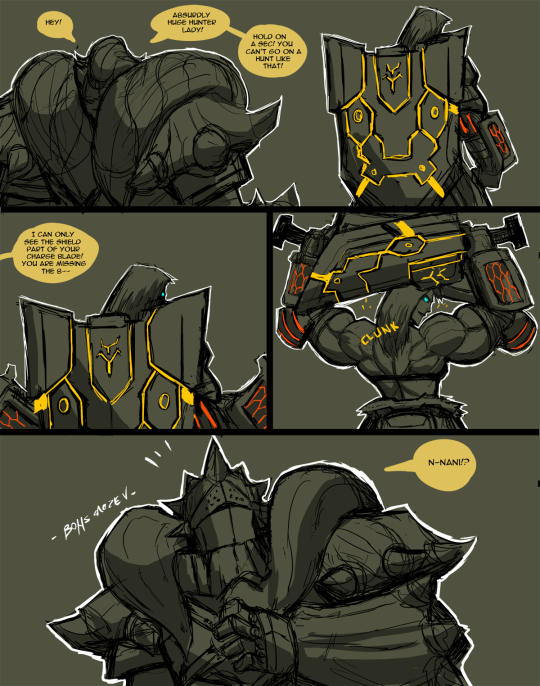
"Those Garangolm Dual Blades are truly built different" WIP (MHR) Wanted to sketch up a comic tribute of my second favorite Dual Blades in the game! I absolutely LOVE these chunky bois, they look like something from Darksiders(my favorite Game series), and look really good on my big berserker lady Beth! Had to poke fun at the fact that they look like a big shield sheathed XD
(shame the ""Extremely"" Buff layered chest is so damn underwhelmingly slim to go with those blades, but it still gives the idea of the character at least, plus I got my goofy art to actually make her accurate, both build and height-wise XD )
#monster hunter#monster hunter rise#mhr#sunbreak#garangolm#dual blades#diablos#beth ravencoft#solikar#vampire hunter#unholy trinity#capcom#crossover
115 notes
·
View notes
Text

Garangolm icon in MHW style. Good monke.
270 notes
·
View notes
Text
Guilty Gear Characters as Monster Hunter Monsters (Part II)
Part I
Wow, I did not expect the reception I got for my first part. Apparently, I have found the fabled niche of legend: the target audience. I also got some neat suggestions, and I'll include a few!
Everything is under the cut, as per usual:



Chipp Zanuff: Tobi-Kadachi or (Silverwind) Nargacuga
The speedy shinobi was going to get some quick monsters to match his brash, quick personality, and the first one is the Tobi-Kadachi with its speed, somersaults, and overall versatility.
I also chose the Tobi-Kadachi for the way that it utilizes static electricity. While Chipp is not usually associated with it, I see the way that it rubs off on its environment to use it to be very like Chipp in how he acts in the spur of the moment.
I also took a page from one of the people who reblogged my previous post and agree with them: the Nargacuga is essentially Chipp.
I went with the Silverwind variant because it has more control over its attacks as well as how hard it can hit. It also has another skill that younger Nargacuga does not: its Wind Cutting White Shadow.
It is also worth noting that the Silverwind Nargacuga is noted to be more aggressive than its younger counterpart, which is very much in line to how Chipp approaches... everything.



Answer: (Ebony) Odogaron or Glavenus
I understand that these monsters are quite aggressive and can definitely pack a punch, but I see Answer as an economically-minded and very efficient man.
As such, the Odogaron is perfect for him because it is built for quick, fatal damage that leaves its victim disoriented and confused as their life leaves them with a karmic quickness.
Two sets of razor-sharp claws each? Lithe, muscle-corded body? Big set of sharp teeth? Yeah, that's a creature that has a very specific purpose.
The Ebony Odogaron takes this a step further by carrying around a piece of meat in its mouth for a quick burst of energy or an additional weapon to be used in its arsenal.
With that being said, the Glavenus literally has a weapon for a tail that it sharpens with its teeth.
The shavings left behind are even conserved in a special sac in its throat that can turn into molten magma that can be spat out as a weapon.
As there's no wastage in any step of the process, I can also confidently apply this monster to Answer.


Queen Dizzy: Alatreon or Garangolm
Look, I know the Alatreon is scary and radiates an energy that has most creatures running away from it, but it's not like Dizzy's power didn't do the same damn thing in the early story, right?
With that being said, I'm going off of the Iceborne Alatreon as it aligns with more of what I mean.
The crown on its head, its control over fire and ice, and the fact that it is described as a "living natural disaster" can all be attributes applied to Dizzy.
However, the Alatreon is not a creature of peace or compassion. It is hell. It is pain. It is death. And so another creature must represent that, which is why I chose the Garangolm.
The Garangolm has an affinity with the plants and around its environment, the sap it emits also promoting growth in said plants.
While it can use fire, water, and ice in its attacks, it is also noted to be mostly docile unless provoked, which falls in line with Dizzy's overall personality.
So in summary, take the Alatreon as a marker of Dizzy's power and the Garangolm as a marker of Dizzy's disposition.

Potemkin: Lao-Shan Lung
I am well aware that Potemkin is an absolute unit, so what other monster could I have picked?
The Lao-Shan Lung is a monster that cares not for the little people around it and only focuses on the clear obstacles in its path.
In this sense, it is very much like Potemkin as his main focus is his objectives and orders given to him by Gabriel.
I also like to think that the Lao-Shan Lung has lived long and has seen much in its time, and in the same sense, Potemkin has been through a lot.
Despite this, as I've said, the Lao-Shan Lung doesn't immediately choose violence and likewise, underneath the muscles and training, Potemkin is a gentle soul that hopes for the best.



Jack-O Valentine: Kecha Wacha or (Blood Orange) Bishaten
These guys are quite goofy in application and style, but they're also quite smart in how they use their respective movesets, however, Jack-O is going to reflect these same traits in various ways.
The Kecha Wacha has a marked curiosity for anything new or interesting in the world around it, preferring to investigate it rather than fight anything, much like Jack-O herself.
The Kecha Wacha also has a myriad of tricks up its sleeves, including a sort of 'mask' that it can wear with its ears, a trunk that can expel water from a distance, long claws that it can use to climb and slash, and glide with the membrane it has around its body.
While the Blood Orange Bishaten is notably more aggressive and violent than the Kecha Wacha, I would say that its utilization of the flaming pinecones it juggles is similar to how Jack-O's minions scatter around and inconvenience her opponents
The Blood Orange Bishaten is also noted to be quite clever and while Jack-O is curious, I will also say that in some instances, she can be quite clever.
If those aren't a bag of tricks to you, I don't know what to tell you.


Ramlethal Valentine: (Crimson Glow) Valstrax or Rathalos
The Valstrax is my favorite Elder Dragon and my favorite monster in Monster Hunter period, and I think that the way it moves jives perfectly with Ramlethal.
The Valstrax's winged limbs can extend to great lengths to hit its opponents and the way it propels itself through the air can be used to levitate and blast its opponents as well.
I chose the Crimson Glow variant as while it is more tortured in a sense, it is also more tied to the ground.
I choose to interpret this as Ramlethal coming down from her perceived purpose as a tool to being a human, boons, banes, and all in the human experience.
It also helps that it is absolutely relentless in the same way that Ramlethal is when she has a task at hand.
In the case of the Rathalos (for the Valentine sisters specifically), I took a little shift and went into creatures that work in tandem.
While the pair of flying wyverns are mates technically, I will go into how they function as a unit as opposed to that aspect.
The Rathalos is more of an aerial unit that is well-equipped to fight anything that comes into its territory. Ramlethal was designed with that specific purpose of combat in mind.


Elphelt Valentine: Espinas or Rathian
While these do seem like weird choices at first, I would like to address her lore for a minute.
Elphelt was made for the specific purpose of infiltration, and as such, went along with life until a very specific moment.
In that moment, the euphoria and joy was so much so that it threw everything out of whack and shocked Elphelt into emotions proper and scrambled her objective.
In that same sense, the programming that was triggered again in the wake of Justice being properly revived caused a litany of damage and ruination.
The Espinas is the definition of the sleeper agent because although mostly passive, once that thing is awake and rightfully pissed off, it is curtains for the poor thing that dared.
It is also funny that the name 'espinas' means 'thorns' in Spanish and every rose is going to have them.
As I've said before, the Ramlethal sisters operate in tandem and as such, the Rathian does more of the job of blending in with its environment with its green hide. Elphelt was made for infiltration.
This does not make it any less dangerous, however, as it can still put up a fight and do a whole lot of damage with its teeth, claws, spikes, and barbed poison tail.
That's another few! I enjoyed this one and like I said before, please feel free to tell me what you think! This is fun.
#narky thinks#going ham#guilty gear#monster hunter#chipp zanuff#tobi-kadachi#nargacuga#answer guilty gear#odogaron#glavenus#queen dizzy#alatreon#garangolm#potemkin#lao-shan lung#jack-o valentine#kecha wacha#bishaten#ramlethal valentine#valstrax#rathalos#elphelt valentine#espinas#rathian
13 notes
·
View notes
Text

13 notes
·
View notes
Text
Hey everyone! I drew a garangolm poorly.
Will draw more soon.

44 notes
·
View notes
Text

Official Monster Hunter Rise: Sunbreak concept art: Garangolm
#Monster Hunter#garangolm#monsterhunterofficial#monster hunter#monhun#monsterhunter#mh#モンスターハンター#モンハン
92 notes
·
View notes
Text
youtube
Here’s the skulls I made for the vid!
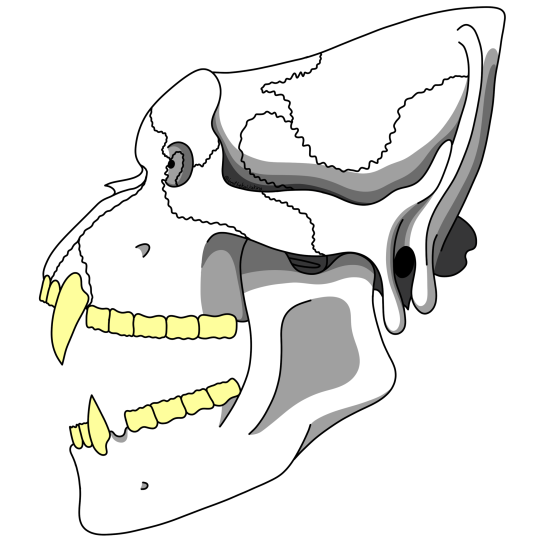
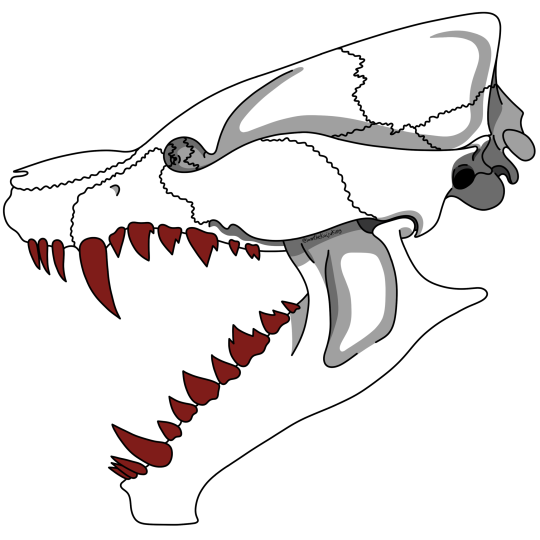
For garang I used Gorillas and Macaques for reference, and for luna I used members of Hesperocyoninae for reference because that’s what I think it is, but like with most things in monhun its phylogenetic placement in the tree of life is kinda subjective.
I don’t have much to say about garang other than, aside from a missing pair of premolars on the mandibles, the dental formula matches perfectly with primates.
I do have more to say on luna however. The pronounced snout arch makes me think Lunagaron might deal with a lot of bite stress and have a very powerful bite. There’s also the long teeth and notch in the tooth line on the upper jaw, which are obvious adaptations for fish eating, but the robustness of the teeth and the iron reinforcement makes me think luna might be more like a cursorial phytosaur or otter, able to eat a wide assortment of things but perfectly capable of eating slippery stuff and being able to crack open armored prey like turtles or mollusks.
I know in the past I’ve said I think luna might have had more aquatic ancestors, and while that’s possible, it’s probably more likely that this trend towards aquatic-ness is actually new. I actually brought up the semi-aquatic luna theory to UHC.
I still stand by a few things I’ve said here such as the thick tail partially being due to fat stores and the scales helping with hydrodynamics and the immune system, but I’m not really sure about luna having one set of teeth anymore.
#youtube#monster hunter#speculative biology#speculative evolution#monsterhunter#monhun#monster hunter biology#speculative anatomy#speculative ecology#speculative zoology#lunagaron#garangolm#monster hunter sunbreak#uhc#unnatural history channel#skulls
107 notes
·
View notes
Text

The listing is up which means preorders are now live! Please make sure to read all the information listed in the listing, but just a general note, by pre-ordering:
-Charms will be $10/each during this time. Once the pre orders are over prices will resume normal price. -You will receive a bonus charm that is only included in this set, and cannot be purchased outside of his pre-order. -ETA will be late April to Early May depending on production/shipping times! Of course any other questions let me know!
#monster hunter#monsterhunter#capcom#magnamalo#malzeno#lunagaron#scorned magnamalo#primordial malzeno#shagaru magala#chaos gore magala#seregios#daimyo hermitaur#garangolm#shogun ceanataur#gaismagorm#preorder
13 notes
·
View notes
Text
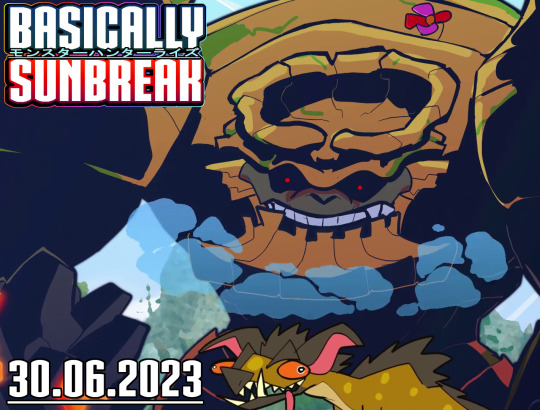

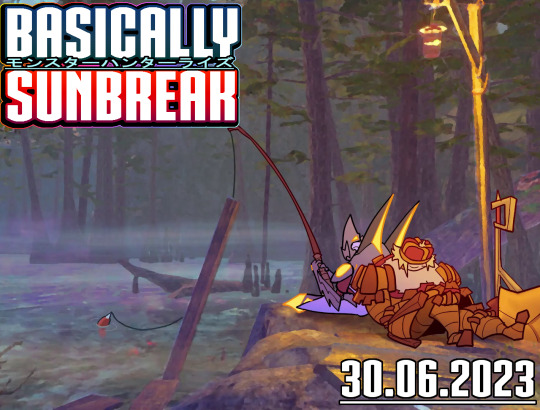


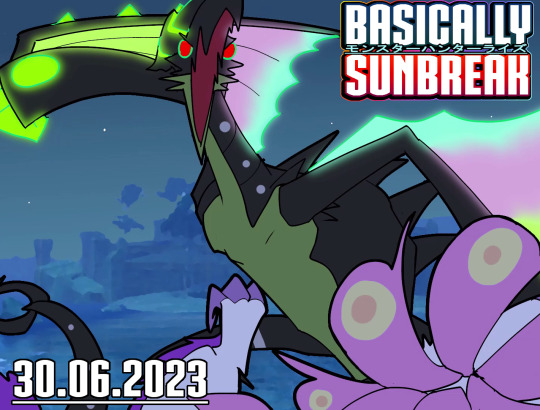
Made promo thumbnails for my own video because that shit is cool and Im not gonna act like I'm above that
#monster hunter#basically sunbreak#you know im gona make amv with my own stuff#hammer chan#valstrax guy#malzeno#garangolm#aurora somnacanth#mizutsune#astalos
117 notes
·
View notes
Text

"Those Garangolm Dual Blades are truly built different" colored (MHR) My best friend got MHR for our coop sessions so I felt like finishing this piece I started a few months ago. Might do more new ones these days we'll see Tribute to my second favorite Dual Blades in the game I absolutely LOVE these chunky bois, they look like something from Darksiders(my favorite Game series), and look really good on my big berserker lady Beth! Had to poke fun at the fact that they look like a big shield sheathed XD Featuring a Hunter and my big DB berserker Beth Ravencoft
#monster hunter#monster hunter rise#monster hunter rise sunbreak#sunbreak#hunter#diablos#bazelgeuse#garangolm#dual blades#crossover#beth ravencoft#vampire hunter#berserker#capcom#mhr#unholy trinity
42 notes
·
View notes